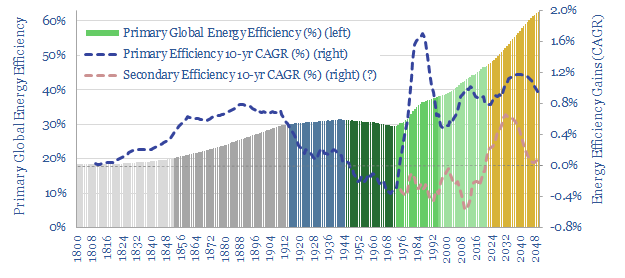Projections of future global energy demand depend on energy efficiency gains, which are hoped to step up from <1% per year since 1970, to above 3% per year to 2050 by some forecasters. But there is a problem. Energy efficiency is vague. This 17-page note explores three definitions. We are worried that global energy demand will surprise to the upside as energy efficiency gains disappoint optimistic forecasts.
Forecasts of future energy demand hinge on energy efficiency. When energy efficiency increases, then less primary energy needs to be supplied to meet the ultimate energy demands of civilization. But definitions matter, as some forecasters are now assuming enormous accelerations of efficiency gains in the energy transition (page 2).
Definition #1. Energy intensity of GDP? The primary energy intensity of global GDP has declined at 1.0% per year since 1970. We can also measure this metric by sector. But there are two great controversies with this measure of energy efficiency (pages 3-4).
Definition #2. Primary energy efficiency is the percent of the thermal energy in fuels that is converted into useful energy for machines. The definition has its roots in the power sector. We have charted 20 examples of energy efficiency factors, which can also be aggregated by fuel, over time, and for the entire global energy system. So we think primary efficiency of the global energy system is around 45% today, has been improving at 0.8% per year, and the gains will accelerate to 1.1% per year through 2050. But this definition only gives a partial picture. See pages 5-9.
Definition #3. Secondary energy efficiency is the percent of useful energy supplied to machinery and appliances that is actually used for its intended thermodynamic purposes. This is the most challenging concept of energy efficiency. It can be almost impossible to define and measure. See pages 10-12.
Efficiency paradox #1. On our best attempts to parse the data, we think secondary energy efficiency has most likely declined on a global average basis over the past half-century. We are not sure whether there is a historical precedent for secondary efficiency to improve on a global average basis (sometimes called Jevons Paradox). Our roadmap to net zero requires an inflection in secondary efficiency from -0.3% per year to +0.2% per year. Others’ roadmaps require an inflection to 2-3% per year. There are very important controversies here. Energy demand could surprise strongly to the upside (page 13).
Efficiency paradox #2. Primary energy efficiency is seen improving from 45% in 2019 to above 60% in 2050 in our roadmap to net zero. However, many transition technologies, especially hydrogen value chains, have round-trip efficiencies well below the global average. How can you increase total global primary efficiency by deploying technologies with lower-than-average primary efficiency?! (page 14).
Efficiency paradox #3. Industrial history has seen primary efficiency of heat engines improve by a factor of 3-5x each century since 1650. This is amazing. But it cannot continue, as primary efficiency is capped at 100%. Although we do think primary efficiency gains enjoy a final 2-3x surge upwards through the deployment of more renewables and electrification, as a mega-trend for the 21st century (page 15).
Our conclusions, bluntly stated, are that some forecasts for declining global energy demand through 2050 may be based on vague, aspirational, and historically unprecedented efficiency assumptions. This matters. Persistent under-supply in global energy markets could de-rail the energy transition (fantasies then crises) and culminate in cruel energy shortages (page 16).
Our favorite opportunities to drive energy efficiency through the global energy system — reducing both primary demand and useful demand — are spelled out on page 17.
